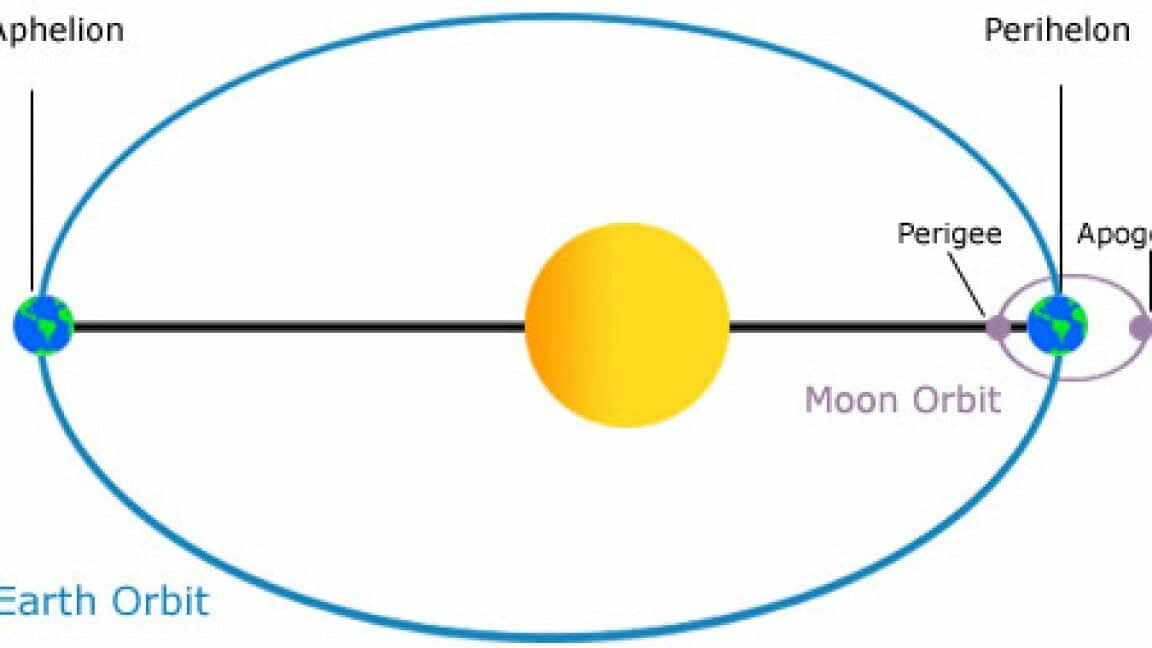An astronomical unit (au or AU) serves as a unit of measurement that approximates the distance between the Earth and the Sun. This distance is roughly equal to 150 million kilometers (93 million miles) or about 8.31 light minutes. The actual value of the astronomical unit varies throughout the year as the Earth orbits around the Sun, reaching its maximum distance (aphelion) and minimum distance (perihelion) once annually. In 2012, the AU was officially defined as exactly 149,597,870,700 meters.
The astronomical unit finds extensive application in measuring distances within the solar system and to other stars. Furthermore, it serves as a crucial component in determining another unit of astronomical length, known as the parsec.
History of the symbol’s use
Throughout history, various symbols and abbreviations have been employed to denote the astronomical unit. In a resolution passed in 1976, the International Astronomical Union (IAU) adopted the symbol A as a representation of the astronomical unit’s length. This symbol, AU, has since become widely used in astronomical literature. However, in 2006, the International Bureau of Weights and Measures (BIPM) recommended the use of ua as the official unit symbol. This recommendation is outlined in Annex C of ISO 80000-3:2006, although it is important to note that this annex is non-normative. Therefore, the symbol for the astronomical unit is officially recognized as “ua”.
In 2012, the International Astronomical Union (IAU) acknowledged that there are various symbols being used to represent the astronomical unit. They recommended the symbol “au”, a recommendation that was also supported by the American Astronomical Society (AAS) in their guidelines for manuscript preparation for their main journals. The Bureau International des Poids et Mesures (BIPM) adopted the unit symbol “au” in the 2014 edition of the International System of Units (SI) Brochure, as well as in the 2019 edition. However, the latest version of ISO 80000-3:2019, which supersedes ISO 80000-3:2006, does not make any mention of the astronomical unit.
Evolution of the unit’s definition
The elliptical shape of the Earth’s orbit around the Sun allows for precise calculations and predictions based on observations. The major semi-axis, which is half the distance between perihelion and aphelion, defines the shape of the orbit. The Sun is located along this line segment, but not in the middle. By measuring the extreme points of the ellipse, astronomers were able to determine the exact shape of the orbit and make calculations for the entire year. This also allowed them to map the Earth’s greatest straight-line distance traveled in a year, helping to predict the times and locations where the greatest parallax (apparent position shifts) in the nearest stars could be observed. By knowing the offset between the Earth and the star, astronomers could calculate the distance to the star. However, all measurements in astronomy are subject to some degree of error or uncertainty, and this uncertainty is compounded when calculating stellar distances based on the length of an astronomical unit. Therefore, improving the accuracy of these measurements has always been a priority in the field of astronomy. Throughout the twentieth century, advancements in technology and the understanding of Einstein’s theory of relativity have led to increasingly precise and sophisticated measurements in the field of astronomy.
In 2006, the magnitude of the astronomical unit was reported by BIPM as 1.49597870691 (6) × 10 m. In the 2014 edition of the SI Brochure, BIPM acknowledged the IAU’s 2012 redefinition of the astronomical unit as 149597870700 m.
This estimation was still derived from observations and measurements, which are susceptible to error and were based on methods that do not standardize all relativistic effects and therefore were not constant for all observers. In 2012, the IAU decided that using the relativity equation alone would have made the definition overly complex, so they simply used the 2009 estimation to redefine the astronomical unit as a conventional unit of length directly linked to the meter (exactly 149597870700 m). The new definition also acknowledges that the astronomical unit will now have a smaller role, limited to its convenience in certain applications.
This definition establishes that the speed of light, which is defined as precisely 299792458 m/s, is equivalent to precisely 299792458 × 86400 ÷ 149597870700 or approximately 173.144632674240 a.u./day, which is about 60 parts per trillion less than the estimate from 2009.
Applications and Significance
In definitions used prior to 2012, the astronomical unit relied on the heliocentric gravitational constant, which is the product of the gravitational constant, G, and the mass of the Sun, M ☉. Although G and M ☉ cannot be individually measured with high accuracy, the value of their product is known with great precision through observations of the relative positions of the planets (expressed in Kepler’s Third Law using Newtonian gravity). Ephemerides only require the product to calculate the positions of the planets, so they are calculated in astronomical units, not SI units.
The calculation of ephemerides also necessitates the consideration of the influences of general relativity. Specifically, the durations of time measured at the Earth’s surface (Terrestrial Time, TT) are not constant in comparison to the movements of the planets: an Earth second (TT) appears longer during the month of January and shorter during the month of July when compared to a “planetary second” (typically measured in TDB). This phenomenon occurs because the distance between the Earth and the Sun is not fixed (it varies from 0.9832898912 to 1.0167103335 a.u.), and when the Earth is closer to the Sun (at perihelion), the Sun’s gravitational field is stronger and the Earth travels faster along its orbital path. As the meter is defined in terms of seconds and the speed of light remains constant for all observers, the length of the Earth’s meter seems to fluctuate periodically in comparison to the “planetary meter.”
The meter is a unit of measurement for proper length, but the SI system does not specify the metric tensor to be used in its definition. The International Committee of Weights and Measures (CIPM) acknowledges that “its definition is only valid within a small spatial dimension where the effects of gravitational field inhomogeneity can be ignored.” Therefore, the meter is not meant to measure distances in the solar system. The 1976 definition of the astronomical unit lacked specification of the reference frame for measuring time, but it was practical for calculating ephemerides. A more comprehensive definition consistent with the general theory of relativity was proposed and a “lively debate” ensued until August 2012, when the IAU adopted the current definition of 1 astronomical unit = 149597870700 meters.
The astronomical unit is frequently employed for measuring distances within stellar systems, such as the dimensions of a protostellar disk or the heliocentric distance of an asteroid. However, other units are utilized for different distances in the field of astronomy. The astronomical unit is too small to be practical for interstellar distances, where the parsec and light-year are commonly used. A parsec (abbreviated as “pc”) is defined in astronomical units as the distance to an object with a parallax of 1 arcsecond. The light-year is often utilized in popular literature, but it is not an officially approved unit outside of the SI system and is seldom used by professional astronomers.
When simulating a numerical model of the solar system, the astronomical unit offers a suitable scale that minimizes errors in floating-point calculations, such as overflow, loss of significance, and truncation.
Historical Background
In the historical account titled On the Dimensions and Distances of the Sun and Moon, originally believed to be authored by Aristarchus, it is mentioned that he made calculations to ascertain that the distance between the Sun and the Moon should be 18-20 times greater than the distance between the Earth and the Moon. However, it is now known that the actual ratio is approximately 389,174. This estimation was based on the angle formed by the crescent moon and the Sun, which he approximated to be 87 degrees (while the accurate value is around 89,853 degrees). Depending on the distance that Van Helden assumed Aristarchus utilized to determine the distance to the Moon, his estimated distance to the Sun would range from 380 to 1,520 times the radius of the Earth.
As per Eusebius of Caesarea in Praeparatio Evangelica (Book XV, Chapter 53), Eratosthenes determined that the Sun is located at a distance of “σταδιων μυριαδας τετρακοσιας και οκτωκισμυριας” (which translates to “55 million years”) >400 and 80000 ″), but with the clarification that in the Greek text, the grammatical agreement is between myriads (not stages) on one side and 400 and 80000 on the other, since in Greek, unlike in English, all three (or all four if we include stages) words undergo declension. This has been interpreted as 40800000000 stadia (in the 1903 translation by Edwin Hamilton Gifford), or 80400000000 stadiums (in the 1974-1991 revision). Assuming a Greek stadium length of 185 to 190 meters, the former translation equates to 754800 kilometers by 775200 km, which is too small, while the latter translation corresponds to 148.7 to 152.8 million kilometers (with an accuracy within 2%). Hipparchus also provided an estimate of the Earth’s distance from the Sun, as quoted by Papp, equal to 490 Earth radii. According to the hypothetical reconstructions by Noel Swerdlow and G. J. Toomer, this value was derived from his assumption of a “least noticeable” solar parallax of 7′.
After the transfer of Greek astronomy to the medieval Islamic world, astronomers in this era made some modifications to Ptolemy’s cosmological model, however, they did not make any significant changes to his estimation of the distance between the Earth and the Sun. To illustrate, in his introduction to Ptolemy’s astronomy, al-Ferghani stated that the average distance to the Sun is 1170 Earth radii, while in his zij al-Battani, he used the average distance to the Sun as 1108 Earth radii. Other astronomers like al-Biruni also employed similar values. Moving forward in Europe, Copernicus and Tycho Brahe likewise utilized comparable figures (1142 and 1150 Earth radii), thereby preserving Ptolemy’s approximate distance from the Earth to the Sun until the 16th century.
Johannes Kepler was the first to recognize that Ptolemy’s estimate must be significantly underestimated (according to Kepler by at least a factor of three) in his Rudolphin Tables (1627). Kepler’s laws of planetary motion enabled astronomers to compute the relative distances of the planets from the Sun and sparked renewed interest in determining the absolute value for the Earth (which could then be extrapolated to other planets). The invention of the telescope allowed for much more precise measurements of angles than were possible with the unaided eye. Flemish astronomer Godefroy Wendelin replicated Aristarchus’ measurements in 1635 and discovered that Ptolemy’s value was at least eleven times too low.
A more precise approximation can be acquired by observing the movement of Venus. By measuring the transit at two separate locations, it is possible to accurately calculate the parallax of Venus and, based on the relative distances of Earth and Venus from the Sun, the solar parallax α (which cannot be directly measured due to the Sun’s brightness). Jeremiah Horrocks made an attempt to estimate this based on his observations of the transit in 1639 (published in 1662), resulting in a solar parallax of 15″, similar to the Wendelin Figure. The solar parallax is linked to the Earth-Sun distance, measured in Earth radii, as the
The smaller the solar parallax, the larger the distance between the Sun and the Earth: the solar parallax is 15″, which is equivalent to a distance of 13750 Earth radii between the Earth and the Sun.
Christiaan Huygens had a different perspective on the distance: by comparing the apparent sizes of Venus and Mars, he came up with an estimate of approximately 24000 Earth radii, which is equivalent to a solar parallax of 8.6″. Even though Huygens’ calculation is remarkably close to modern estimates, historians of astronomy tend to overlook it due to the numerous unproven (and incorrect) assumptions he relied on for his method to work. It seems that the accuracy of his estimate was more a result of luck rather than precise measurement, as his various errors offset each other.
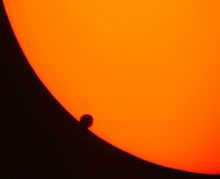
Observing the transits of Venus as it passes across the surface of the Sun has been a highly effective way to measure the astronomical unit for a long time, despite the challenges posed by the “black drop effect” and the infrequency of such observations.
In 1672, Jean Richer and Giovanni Domenico Cassini conducted a measurement of the parallax of Mars, comparing observations from Paris and Cayenne in French Guiana. This happened when Mars was at its closest point to Earth. The result of their measurement was a solar parallax of 9.5″, which can be translated into an Earth-Sun distance of approximately 22,000 Earth radii. This was a significant achievement as they were the first astronomers to have access to an accurate and reliable estimation of the Earth’s radius. Their colleague Jean Picard had measured the Earth’s radius in 1669 as 3269,000 tuaz. Another colleague, Ole Rømer, made a groundbreaking discovery in 1676 by proving that light has a finite speed. This speed was so immense that it became a common practice among astronomers to refer to it as the time it takes for light to travel from the Sun to the Earth, also known as “light time per unit distance.”
| 1895 | aberration | 149.25 | 0.12 |
| 1941 | parallax | 149.674 | 0.016 |
| 1964 | radar | 149.5981 | 0.001 |
| 1976 | telemetry | 149.597870 | 0.000001 |
| 2009 | telemetry | 149.597870700 | 0.000000003 |
Another technique involved determining the constant of aberration. Simon Newcomb placed significant importance on this approach when he obtained his widely accepted solar parallax measurement of 8.80″ (which is close to the modern value of 8.794143″), although Newcomb also utilized data from Venus transits. Newcomb also collaborated with A. A. Michelson in order to measure the speed of light using equipment on the ground; when combined with the aberration constant (which is connected to the time it takes for light to travel a specific distance), this provided the first direct measurement of the distance between the Earth and the Sun in kilometers. The solar parallax value determined by Newcomb (as well as the aberration constant and the Gaussian gravitational constant) was included in the initial international system of astronomical constants in 1896, which was employed in calculating ephemerides until 1964. The term “astronomical unit” appears to have been first used in 1903.
The detection of the nearby asteroid 433 Eros and its close approach to Earth in 1900-1901 provided a substantial enhancement in the measurement of parallax. A separate global initiative was carried out in 1930-1931 to determine the parallax of 433 Eros.
In the early 1960s, direct radar measurements of distances to Venus and Mars became accessible. These measurements, along with more precise determinations of the speed of light, revealed a discrepancy between Newcomb’s values for solar parallax and constant aberration.
Progress
The concept of the astronomical unit has been developed to serve as a reference point for measuring stellar parallaxes (please note that the distances in the image are not represented to scale).
There are alternative ways to express the value of the unit distance A (the astronomical unit value in meters) by utilizing various astronomical constants:
For instance, G represents Newton’s gravitational constant, M ☉ denotes the mass of the Sun, k signifies the numerical value of the Gaussian gravitational constant, and D stands for the time period of one day. As the Sun continues to emit energy and lose mass, the orbits of the planets gradually expand away from it. Consequently, there have been suggestions to discontinue the use of the astronomical unit as a standard unit of measurement.
Due to the fact that the speed of light has a precisely defined value in SI units, and the Gaussian gravitational constant k is fixed in the astronomical system of units, measuring the time it takes for light to travel a certain distance is exactly the same as measuring the product of G and M ☉ in SI units. This means that it is now possible to create ephemerides entirely in SI units, which is becoming more and more common.
An examination of radiometric measurements in the inner solar system in 2004 revealed that the steady increase in the distance unit was much larger than what can be accounted for by solar radiation, with a deviation of +15 ± 4 meters per century.
However, other authors have not been able to confirm these measurements of the steady variations in the astronomical unit, and they are highly inconsistent. Additionally, the estimation of the astronomical unit by planetary ephemerides has not been conducted since 2010.
Examples
Here is a summary of various distances in astronomical units. The table includes a range of examples that are not typically expressed in astronomical units due to their extreme brevity or length. Distances tend to fluctuate over time. The examples are presented in ascending order of distance.
| Light second | 0,002 | – | the distance covered by light in one second | – |
| distance to the Moon | 0,0026 | – | Average distance from Earth, which the Apollo mission took about 3 days to reach | – |
| Sun’s radius | 0,005 | – | The radius of the Sun (695,500 kilometers, 432,450 miles, one hundred times the radius of Earth, or ten times the average radius of Jupiter) | – |
| Light minute | 0,12 | – | the distance covered by light in one minute | – |
| Mercury | 0,39 | – | average distance from the Sun | – |
| Venus | 0,72 | – | average distance from the Sun | – |
| Earth | 1,00 | – | average distance of the Earth’s orbit from the Sun (sunlight takes 8 minutes and 19 seconds to reach the Earth) | – |
| Mars | 1,52 | – | average distance from the Sun | – |
| Light hour | 7,2 | – | The distance covered by light in one hour | – |
| Kuiper Belt | 30 | – | Inner edge begins at about 30 au | |
| Eris | 67,8 | – | average distance from the Sun | – |
| Voyager 2 | 122 | – | distance from the Sun in 2019 | |
| Voyager 1 | 149 | – | distance from the Sun in 2020 | |
| Light day | 173 | – | The distance covered by light in one day | – |
| Light year | 63,241 | – | The distance covered by light in one Julian year (365.25 days). | – |
| Oort cloud | 75,000 | ± 25,000 | distance from the outer edge of the Oort cloud from the Sun (estimated, corresponds to 1.2 light-years) | – |
| Parsec | 206,265 | – | one parsec. Parsec is defined in astronomical units, used to measure distances outside the solar system, and is about 3.26 light-years: 1 pc = 1 au / tan (1″) | |
| Proxima Centauri | 268,000 | ± 126 | The distance to the nearest star to the solar system | – |
| Galactic center | 1,700,000,000 | – | The distance from the Sun to the center of the Milky Way | – |
Citations
Additional resources
Useful links
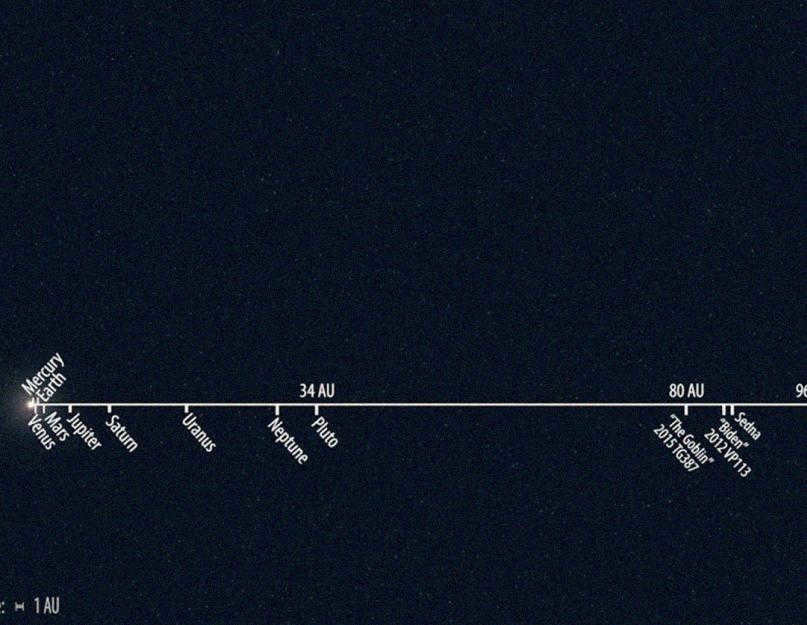
A recently discovered celestial body may establish a fresh record as the most remote dwarf planet in the solar system. This celestial body, known as V774104, is situated at a distance of fifteen billion kilometers away from the Sun, which is two to three times farther than Pluto. V774104 has a size that is slightly less than half of Pluto’s and, similar to Pluto, it has the ability to approach or move away from the Sun while orbiting, although further clarification is required regarding these specifics.
"That’s pretty much all we know about her. We’re not even aware of its orbit because we stumbled upon it a couple of weeks ago," Scott Sheppard of the Carnegie Institution for Science, one of the individuals who found the new object, informed the publication. The discovery is part of a larger expedition for items in this frigid, unlit region beyond Pluto’s orbit, where scientists aspire to uncover hints about the early solar system.
Sheppard revealed the finding at the yearly gathering of the American Astronomical Society on November 10. He informed Space.com that V774104 is without a doubt one of the most remote objects ever observed, although more precise information is required to officially designate it as the most distant dwarf planet.
Sheppard collaborated with Chadwick Trujillo of Gemini in Hawaii and Dave Tholen of the University of Hawaii in his quest.
“We are currently conducting the most extensive and comprehensive survey of objects in the outer solar system ever undertaken,” Sheppard stated. “We are utilizing the impressive 8-meter Subaru telescope located in Hawaii to aid us in our search for celestial bodies that lie beyond the Kuiper Belt and Pluto’s orbit.”
According to Sheppard, objects in the outer solar system are both faint and uncommon. To overcome these challenges, the team of researchers has chosen to utilize the Subaru telescope due to its ability to gather significant amounts of light in a short period of time. Additionally, the telescope is capable of scanning large portions of the sky at an accelerated pace, which Sheppard believes is crucial in uncovering these elusive treasures.
Does life exist beyond Neptune?
There exists a collection of frigid, icy celestial bodies known as the Kuiper belt, situated beyond the orbit of Neptune (which includes Pluto). While Pluto is located 8 billion kilometers away from the Sun, astronomical units (1 a.e. = the distance between the Earth and the Sun, approximately 150 million kilometers) are typically used when discussing the Solar System. On average, Neptune is positioned 30.1 a.e. away from the Sun, while Pluto orbits between 29 and 49 a.e.
Based on the measurements of V774104, the object is currently situated 103 a.e. away from the Sun, placing it within the realm of the Oort cloud. The Oort cloud is a hypothetical sphere composed of solid, icy objects that envelops the entire solar system.
Astronomers have knowledge of comets with long periods that come from the outer Oort cloud, which means they travel distances ranging from 5,000 to 100,000 astronomical units from the Sun, according to Sheppard. These particular comets are considered to be “the most remote objects in the solar system,” although they do not remain exclusively in the outer regions. None of these long-period comets approach the size of a dwarf planet or minor planet.
Silent path
Sedna and VP113 are situated at a considerable distance from the inner solar system (which is the nearest planetary system to Earth) so as not to be influenced by the gravitational pull of the system’s eight planets, as stated by Sheppard.
“Sedna and VP113 are the sole objects that are completely detached from the vast planetary realm,” Sheppard asserts. – Nevertheless, they possess highly elliptical orbits, which makes them particularly intriguing. Based on our knowledge of the solar system, their orbits should remain undisturbed. They should not have formed in such orbits. Something must have caused their disruption.”
That is the reason why Sheppard and Trujillo are currently engaged in researching the distant regions of the solar system. Their objective is to locate celestial bodies that have remained intact since the early stages of the solar system’s existence, thereby exhibiting the same behavior as they did 4.6 billion years ago when the system was formed. According to Sheppard, the prevailing hypothesis concerning the formation of the solar system suggests that the Sun originated “in an extremely dense stellar environment, alongside the appearance of a few nearby stars.” It is possible that the gravitational influence exerted by these stars could have disrupted objects such as Sedna.
On the other hand, it is also plausible that there exists a massive object beyond the orbit of Pluto, whose identity remains unknown, that is responsible for the gravitational disturbance observed in the inner Oort cloud objects.
“According to Sheppard, there is a possibility that some of the objects located in the inner Oort cloud could reach sizes comparable to Mars or even Earth. However, this is difficult to confirm as the distance of these objects from Earth makes them very dim and undetectable with current technology.”
Further research on the objects in this outer region will provide more insight.
“Our goal is to locate more objects similar to VP113, which we discovered last year,” Sheppard explains. “There are multiple theories regarding the origin of these distant objects and their eccentric orbits. Each theory predicts different distributions and populations of these objects. If we can find around 10 such objects, we can start determining which theories accurately explain the formation of these objects.”
An international group of researchers has announced the detection of the farthest object ever found within our solar system. This remarkable discovery marks the first time that an object has been identified at a distance exceeding one hundred astronomical units, which is equivalent to the average distance between the Earth and the Sun.
The scientists responsible for this breakthrough have given the newly found celestial body the nickname “Distant”, although it has now been officially named 2018 VG18, as declared by the Small Planets Center of the International Astronomical Union in a recent announcement.
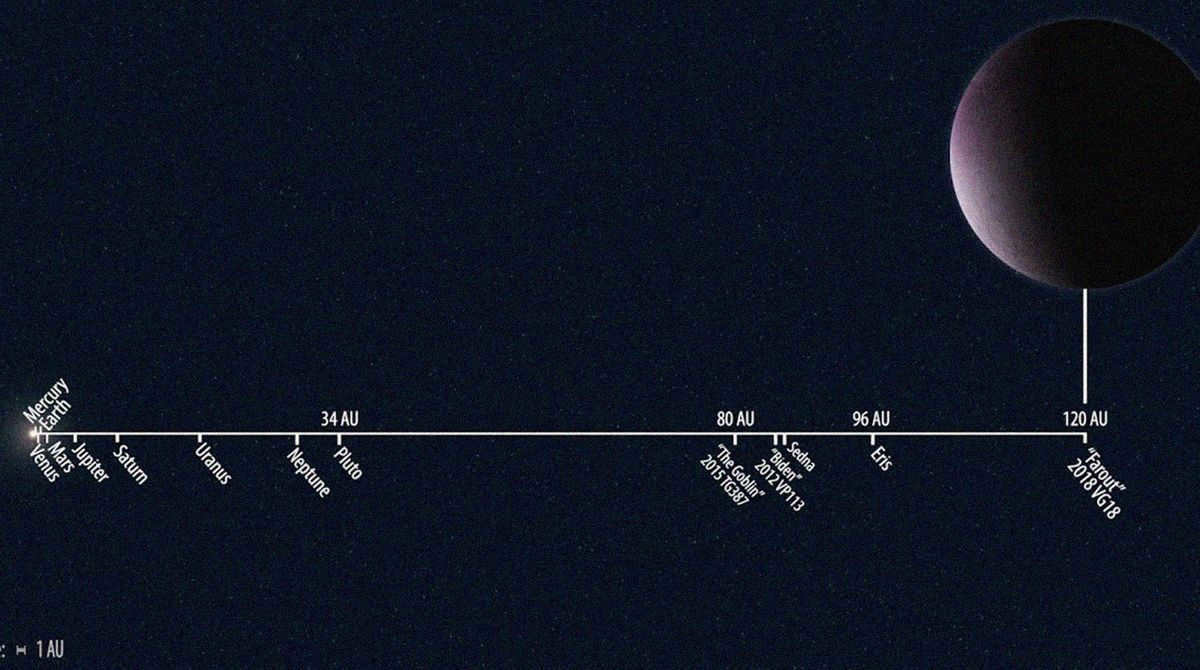

Roberto Molar Candanosa/Scott S. Sheppard/Carnegie Institution for Science
“The information we have on the object 2018 VG18 is limited to its incredibly far distance from the Sun, its estimated size, and its unique hue,” stated David Tholen, a scientist at the University of Hawaii. – Due to its vast distance, 2018 VG18 rotates at an extremely slow pace, and it likely takes over a millennium to complete one orbit around the Sun.”
The American spacecraft Voyager 2, which recently entered interstellar space, has reached a distance of 120 astronomical units from the Sun, similar to the distance of the newly discovered object 2018 VG18. However, it should be noted that while 2018 VG18 is the most distant object that has been observed, it is not the farthest known object in the solar system. For instance, the transneptunian object Sedna has an orbit that takes it more than 900 astronomical units away from the Sun at its farthest point. Additionally, it is believed that there are trillions of comets in the Oort Cloud, which can be found at distances ranging from 5,000 to 100,000 astronomical units. 2018 VG18 was first detected by the Subaru telescope in Hawaii and its existence was later confirmed by the Magellan Telescope in Chile.
Observations have revealed that the body has a size of approximately 500 kilometers, suggesting a rounded shape and classifying it as a dwarf planet. The planet’s pinkish hue suggests a high concentration of ice in its composition.
Scott S. Sheppard/David Tholen
This group of scientists is actively exploring the farthest reaches of the solar system in search of the hypothesized ninth planet, which was predicted in 2016. The existence of this planet was inferred from irregularities in the movements of various previously identified celestial bodies.
“2018 VG18 is the furthest and slowest-moving of the previously identified entities, thus requiring multiple years to completely ascertain its trajectory,” stated Sheppard. – Nevertheless, it was detected in the identical celestial area as formerly discovered remote entities within the solar system, implying that the majority of their orbits are analogous. The resemblance in orbits demonstrated by numerous diminutive remote entities in the solar system persuades us of the presence of a remote, colossal planet that guides these minor entities.”
Due to the vast distance of the mysterious ninth planet’s orbit, which can span hundreds or even thousands of astronomical units, it has the ability to alter the trajectories of other far-off celestial bodies that are unaffected by the gravitational pull of the larger planets in our solar system. Consequently, by studying the deviations of these smaller objects, astronomers may be able to pinpoint a specific region of the sky where the potential existence of a ninth planet could be confirmed in the future.
“This remarkable discovery was truly a collaborative effort on an international scale, utilizing telescopes situated in Hawaii and Chile, and involving various organizations and universities in the United States,” stated Chadwick Trujillo, one of the co-authors of the research paper.
The solar system can be described as a collection that includes a central star, known as the Sun, as well as various celestial bodies that orbit around it.
Within the solar system, there are numerous components, including:
- The Sun, which is the sole star in this particular system;
- A total of 8 planets, with Earth being one of them;
- 415 satellites;
- Additionally, there are tens or even hundreds of thousands of smaller objects, such as comets, meteoric bodies, and cosmic dust, among others.
As for the arrangement of the planets in relation to the Sun, the order is as follows:
- The first planet is Mercury;
- Venus is the second planet;
- Earth is the third planet;
- Mars is the fourth planet;
- Jupiter is the fifth planet;
- Saturn is the sixth planet;
- Uranus is the seventh planet;
- The eighth and final giant planet is Neptune;
- (Once considered the ninth planet, furthest from the Sun, but reclassified as a “dwarf planet” in 2006) – Pluto.
The solar system’s planets are categorized into groups:
Inner planets (Earth-like planets):
Outer planets (giant planets):
In 2006, a new type of object in the solar system was introduced, known as “dwarf planets“. These include:
Planets of the Solar System (along with dwarf planets)
The terrestrial planets, also known as the inner planets
A celestial body classified as an Earth-type planet consists of silicate rocks or metals and has a solid surface layer primarily composed of silicon dioxide.
These planets are situated closer to the Sun and include Mercury, Venus, Earth, and Mars. Despite their small masses and sizes, they exhibit unique characteristics.
The Earth-type planets also exhibit a distinct lack of natural satellites, with few or no moons in their orbit.
Mercury, the innermost planet in our solar system, holds the record for being the closest to the Sun. Its average distance from the Sun is approximately 57.9 million kilometers, but it can range from as close as 46 million kilometers to as far as 69.8 million kilometers.
Notably, Mercury is also recognized as the smallest planet in our solar system. In 2012, scientists made a significant discovery when they detected traces of organic material on its surface.
On the other hand, Earth, the largest terrestrial planet, stands out among its counterparts.
Planets beyond the inner solar system
The star at the center of our solar system, known as the Sun, holds the title for being the largest celestial body. However, there are a group of planets known as gas giants that follow closely behind in size. These giant planets include Jupiter, Saturn, Uranus, and Neptune.
A gas giant is a massive planet primarily made up of gases like hydrogen and helium, with a relatively small solid core. Unlike rocky planets like Earth, gas giants lack a distinct surface. This means that there is no clear boundary between their atmospheres and their surfaces, making it impossible to land on these planets.
The atmospheres of gas giants gradually become denser as you move towards the core. It is possible that there are liquid or liquid-like states between the atmosphere and the core, but this has yet to be confirmed.
Ice Giants
Ice giants are a distinct class of gas giants. There are two planets in our solar system that fall into this category: Uranus and Neptune.
Unlike Jupiter and Saturn, which consist primarily of hydrogen and helium, the ice giants are composed mainly of ice. Uranus has temperatures that can reach as low as -220ºC, while Neptune has an average temperature of around -230ºC.
Jupiter holds the title for being the largest planet in our solar system.
The dimensions of the planets in the solar system
Provided here is information sourced from NASA regarding the approximate radii of the eight planets within our solar system (ordered by size, from smallest to largest) along with a rounded percentage comparing each planet’s radius to that of Earth.
Our galactic system
Our galactic system is known as the Milky Way. As per scientific analysis, the Milky Way is classified as a spiral system with a diameter measuring approximately 100,000 light-years and a thickness of 1 light-year.
Furthermore, based on their calculations, the Milky Way comprises of 150-200 billion stars and an extensive assortment of other celestial objects of various kinds.

Technically, it is feasible to observe the Milky Way at any given moment throughout the year in any location across the globe, although the most opportune period to catch a glimpse of it is typically between mid-March and mid-October.
Urban areas, and even rural communities, are unfortunately plagued by the issue of light pollution, making it impossible to view the Milky Way from such locales. Consequently, in order to maximize your chances of witnessing this celestial spectacle, it is imperative to venture as far away from densely populated regions as feasible.
Alternate Solar Systems
The term “Solar System” is reserved for our own planetary system. However, astronomers have identified over 2500 additional stars within our galaxy, each hosting their own orbiting planets.
Among the 200 billion stars in our galaxy, our sun is merely one. This vast number of stars provides scientists with ample opportunities to explore exoplanets, which are planets located outside of our own solar system.
Neptune is the farthest planet in the solar system and is considered the eighth planet. Previously, Pluto held this title but it was “demoted” to a planetoid by the International Astronomical Union. This decision was made after the discovery of several other small planets, including one (Erida) that is even larger than Pluto. In terms of size, Neptune is the fourth largest planet in diameter and the third largest in mass in the solar system. Its mass is 17.2 times that of Earth and its equatorial diameter is 3.9 times that of our planet. Neptune gets its name from the Roman god of the seas.
Neptune was the initial celestial body to be found (in the year 1846) through the application of mathematical calculations instead of the typical process of observation. The reason for this deviation was due to unexpected alterations in its orbital path, which led to the formation of a hypothesis regarding the existence of an unidentified planet exerting its gravitational force on Uranus. Ultimately, Neptune was located precisely where it was anticipated to be based on mathematical predictions.
Neptune and the Sun are separated by an average distance of 4.55 billion kilometers (equivalent to about 30.1 times the average distance between the Sun and Earth, or 30.1 astronomical units). The time it takes for Neptune to complete one orbit around the Sun is 164.79 Earth years. The planet also rotates on its axis, completing one rotation every 15 hours and 8 minutes. Similar to Earth and Mars, Neptune has an axial tilt of 28.32 degrees, resulting in similar seasonal changes. However, due to its long orbital period, each season on Neptune lasts for forty years.
Neptune’s atmosphere is filled with the most powerful winds out of all the planets in our solar system. It has been estimated that these winds can reach incredible speeds of 2100 km/h (about 600 m/s) (!). The weather on Neptune is defined by an incredibly dynamic storm system. The majority of the winds on Neptune blow in the opposite direction of the planet’s rotation on its axis. In the year 1989, a remarkable feature known as the Great Dark Spot, similar to the Great Red Spot on Jupiter, was discovered in the southern hemisphere of Neptune. The upper atmosphere of Neptune has a temperature close to -220 °C. In the center of Neptune, the temperature is estimated to range between 5400 °K and 7000-7100 °C, which is comparable to the temperature on the surface of the Sun and similar to the internal temperature of most known planets.
Similar to the gas giants found in our solar system, Neptune possesses a feeble and fragmented set of rings, which were officially confirmed in 1989. Due to their elusive nature, these rings are exceptionally challenging to observe from our planet. These rings are believed to consist of ice particles that are coated with silicates, or possibly a carbon-based substance, which is likely responsible for their distinct reddish coloration.
Currently, Neptune is known to have a total of 13 satellites. Among these, the largest one weighs more than 99.5% of the combined masses of all of Neptune’s satellites. It is also the only satellite that is massive enough to have a spheroidal shape. This special satellite is called Triton and it was discovered by William Lassell just 17 days after the discovery of Neptune. Triton is even larger in size and mass compared to our Moon. What makes Triton unique is its reverse direction of orbital motion.
Due to tidal acceleration, Triton is gradually moving closer to Neptune and it is predicted that eventually it will reach the Roche limit. This will result in Triton collapsing and forming a ring around Neptune. This ring might even be more impressive than the famous rings of Saturn. This whole process is expected to happen within a relatively short time period in astronomical terms, spanning from 10 to 100 million years.
In 1989, Triton held the title for being the coldest object in the entire solar system, as its temperature was measured to be around -235 °C (38 °K). Triton is also one of the three satellites in the solar system that have atmospheres. The other two satellites with atmospheres are Io and Titan.
Neptune has only been explored by one spacecraft, Voyager 2, which made a close flyby of the planet in 1989.
Planets in the Solar System
Based on the official stance of the International Astronomical Union (IAU), the organization responsible for naming celestial objects, there are only 8 recognized planets.
In 2006, Pluto was reclassified as a dwarf planet due to the existence of larger objects in the Kuiper Belt. If Pluto were to be considered a full-fledged planet, Eridu, which is nearly the same size as Pluto, would also need to be included in this category.
According to the MAC definition, there are 8 known planets: Mercury, Venus, Earth, Mars, Jupiter, Saturn, Uranus, and Neptune.
All planets can be classified into two groups based on their physical characteristics: terrestrial planets and gas giants.
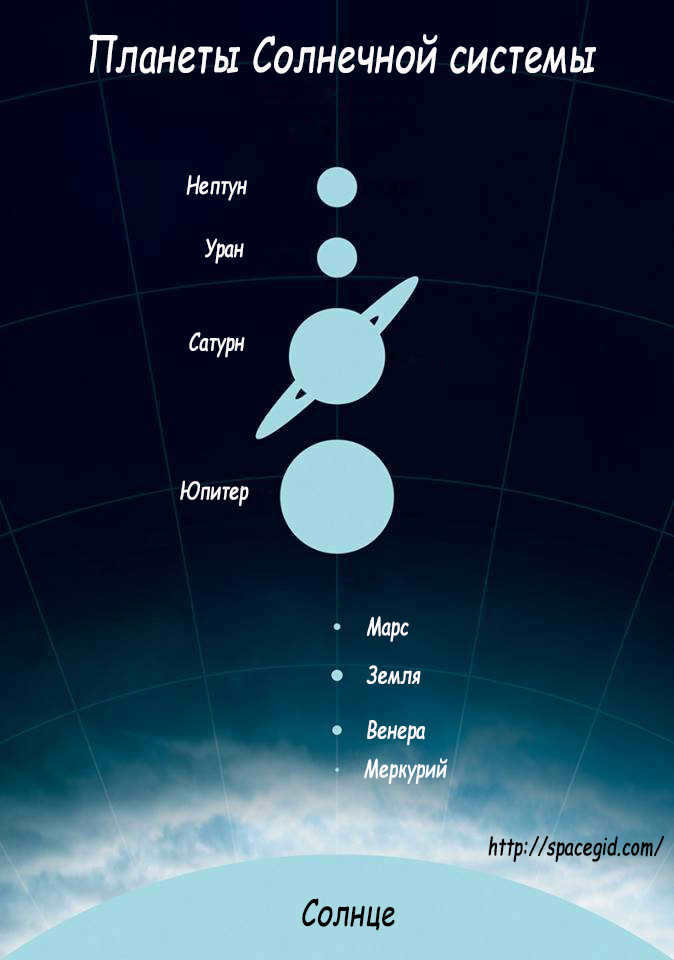

Illustration depicting the organization of the celestial bodies
Rocky planets
The planet Mercury
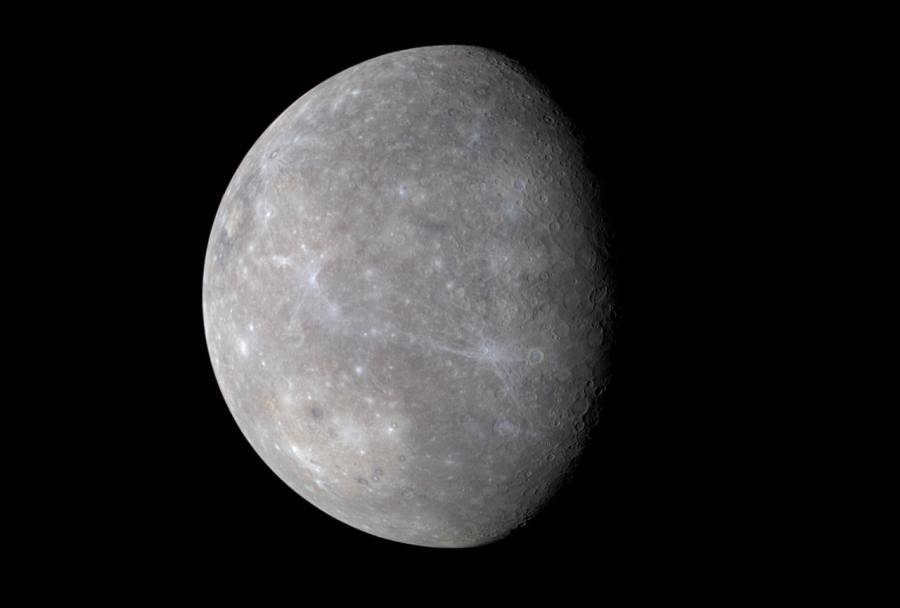
Mercury in color, image from the MESSENGER spacecraft
Mercury experiences the most extreme temperature changes among the planets in our solar system due to its close proximity to the Sun. During the day, the average temperature reaches a scorching 350 degrees Celsius, while at night it drops to a chilling -170 °C. Scientists have detected the presence of sodium, oxygen, helium, potassium, hydrogen, and argon in Mercury’s atmosphere. There is a hypothesis suggesting that Mercury was once a moon of Venus, but this idea has yet to be proven. Unlike other planets, Mercury does not have any natural satellites orbiting around it.
Venus
Venus is the second planet from the Sun and its atmosphere is predominantly composed of carbon dioxide. It is commonly referred to as the Morning Star and the Evening Star due to its visibility after sunset and before dawn, when other stars are not visible. The atmosphere of Venus consists of approximately 96% carbon dioxide, with nitrogen accounting for nearly 4% and trace amounts of water vapor and oxygen.
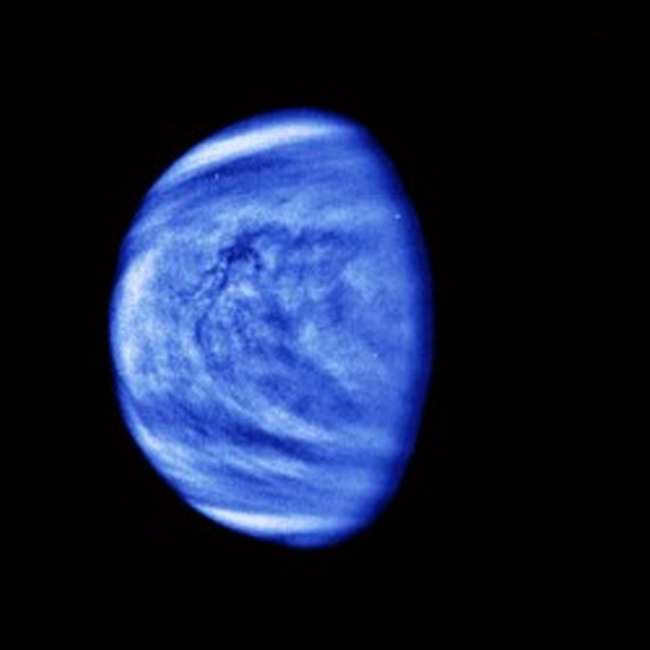
Due to its atmosphere, Venus experiences a greenhouse effect, resulting in surface temperatures that surpass even those on Mercury, reaching up to 475 °C. One interesting characteristic of Venus is its leisurely rotation, with a Venusian day lasting 243 Earth days, which is almost equal to a year on Venus, which is 225 Earth days. Many refer to Venus as Earth’s sister due to its similar mass and radius, which closely resemble Earth’s values. Venus has a radius of 6052 km, which is approximately 0.85% of Earth’s radius. Similar to Mercury, Venus does not have any satellites.
The third planet from the Sun and the sole one in our solar system to possess liquid water on its surface, which is essential for the development of life as we know it. With a radius of 6371 kilometers, the Earth differs from other celestial bodies in our solar system as over 70% of its surface is covered by water, while the remaining space is occupied by continents. An additional distinguishing characteristic of the Earth is the presence of tectonic plates beneath its mantle, capable of slow movement, leading to gradual changes in the landscape. The planet’s velocity is approximately 29-30 km/s.
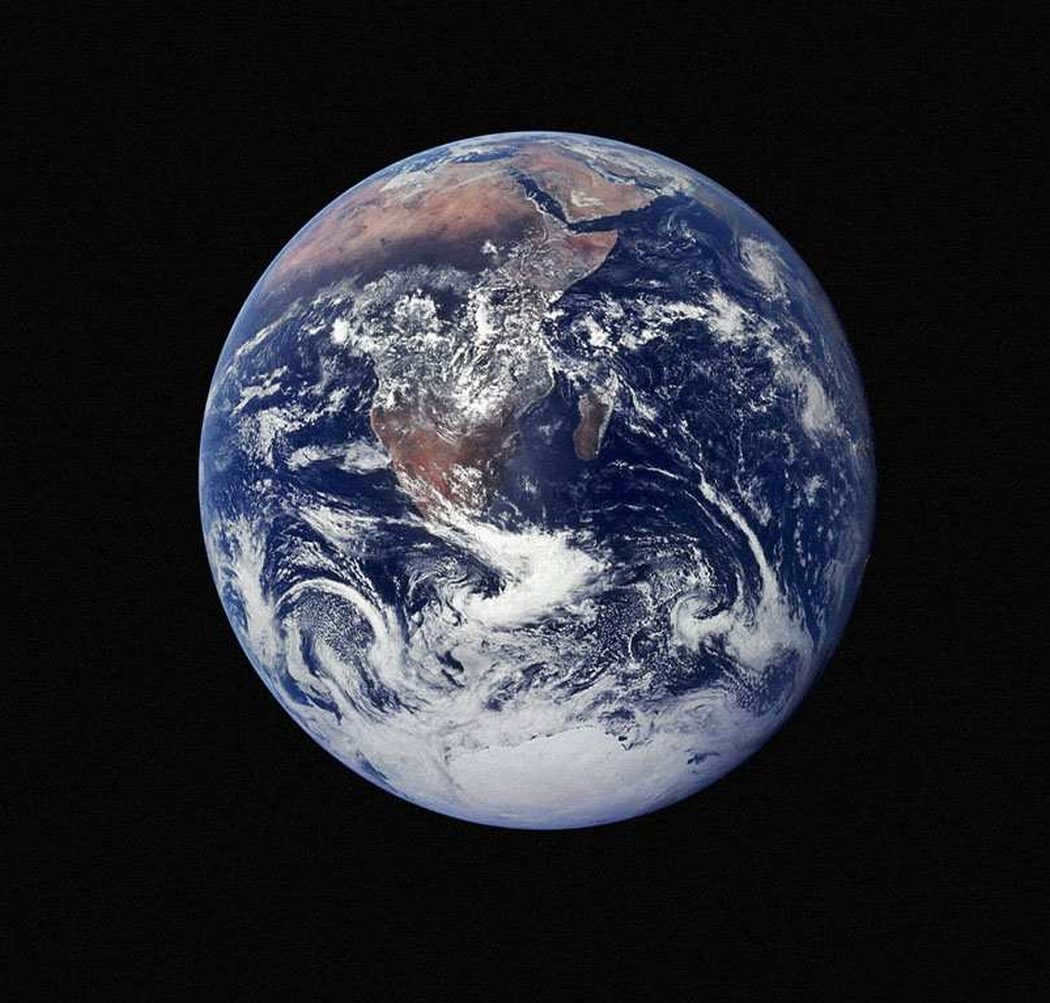

The Earth takes nearly 24 hours to complete one rotation on its axis, and it takes 365 days to complete one orbit around the Sun, making it significantly longer than the orbit of its closest neighboring planets. The duration of a day and a year on Earth are commonly used as a reference for understanding time intervals on other planets. Additionally, Earth is accompanied by one natural satellite, known as the Moon.
Mars
Mars, also known as the Red Planet, is the fourth planet from the Sun in our solar system. It is named after the Roman god of war due to its reddish appearance, which is caused by iron oxide (or rust) on its surface. Mars is a terrestrial planet with a thin atmosphere, and it is the second smallest planet in our solar system, after Mercury. Despite its smaller size, Mars has the largest volcano and the deepest canyon in our solar system. The volcano, called Olympus Mons, is about three times the height of Mount Everest, while the canyon, called Valles Marineris, is about four times as deep as the Grand Canyon. Mars has been a subject of interest for scientists and astronomers for many years, and several missions have been sent to explore the planet. These missions have provided valuable information about Mars’ geology, climate, and potential for hosting life. In recent years, there has been a growing interest in the possibility of sending humans to Mars, with plans for manned missions being developed by space agencies and private companies.
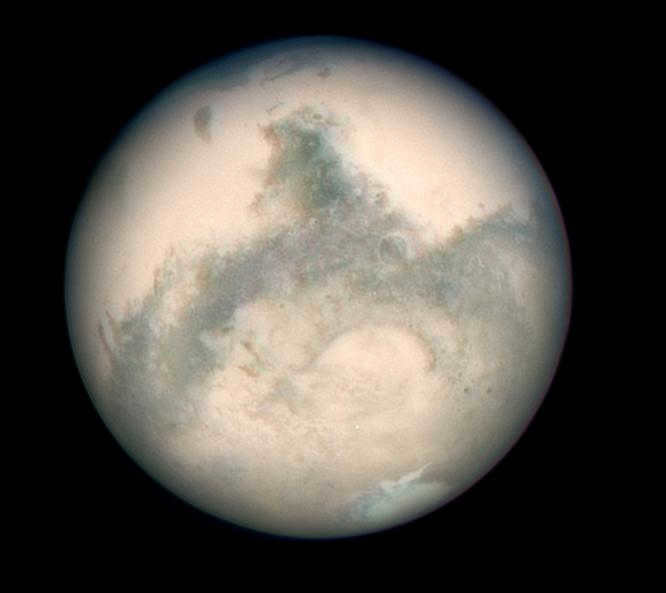
Mars, the fourth planet from the Sun, is famous for its thin atmosphere. Scientists from various countries, including the USSR and the United States, have been actively exploring Mars since 1960. While not all exploration missions have been successful, the discovery of water in certain areas suggests that Mars may have supported or currently supports primitive life.
Mars is easily visible from Earth due to its brightness and does not require any instruments to observe. During its opposition, which occurs every 15-17 years, Mars becomes the brightest object in the sky, even outshining Jupiter and Venus.
With a radius of approximately half that of Earth, Mars has a diameter of 3390 km. However, its year is much longer, lasting 687 days. In addition, Mars has two moons, Phobos and Deimos.

